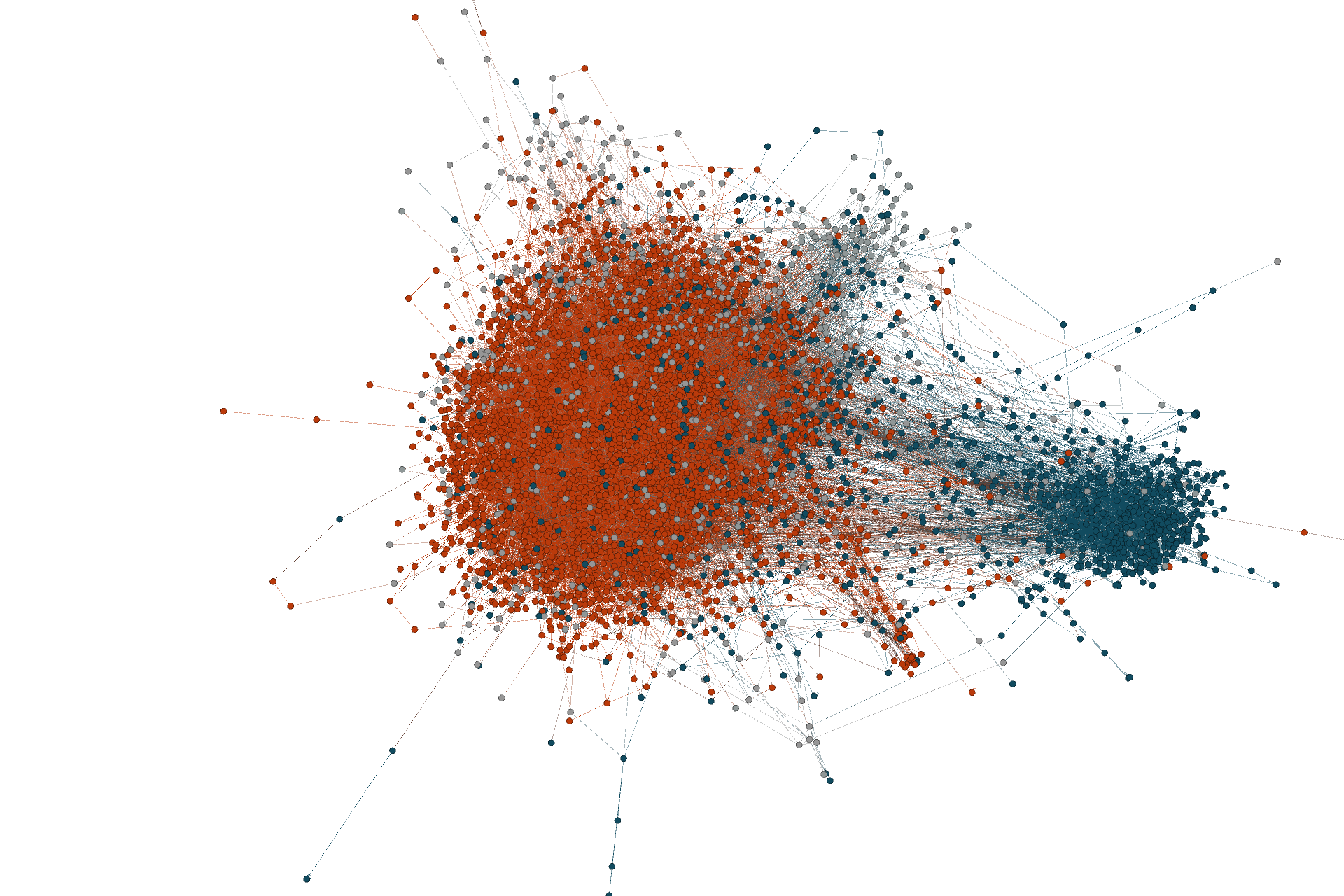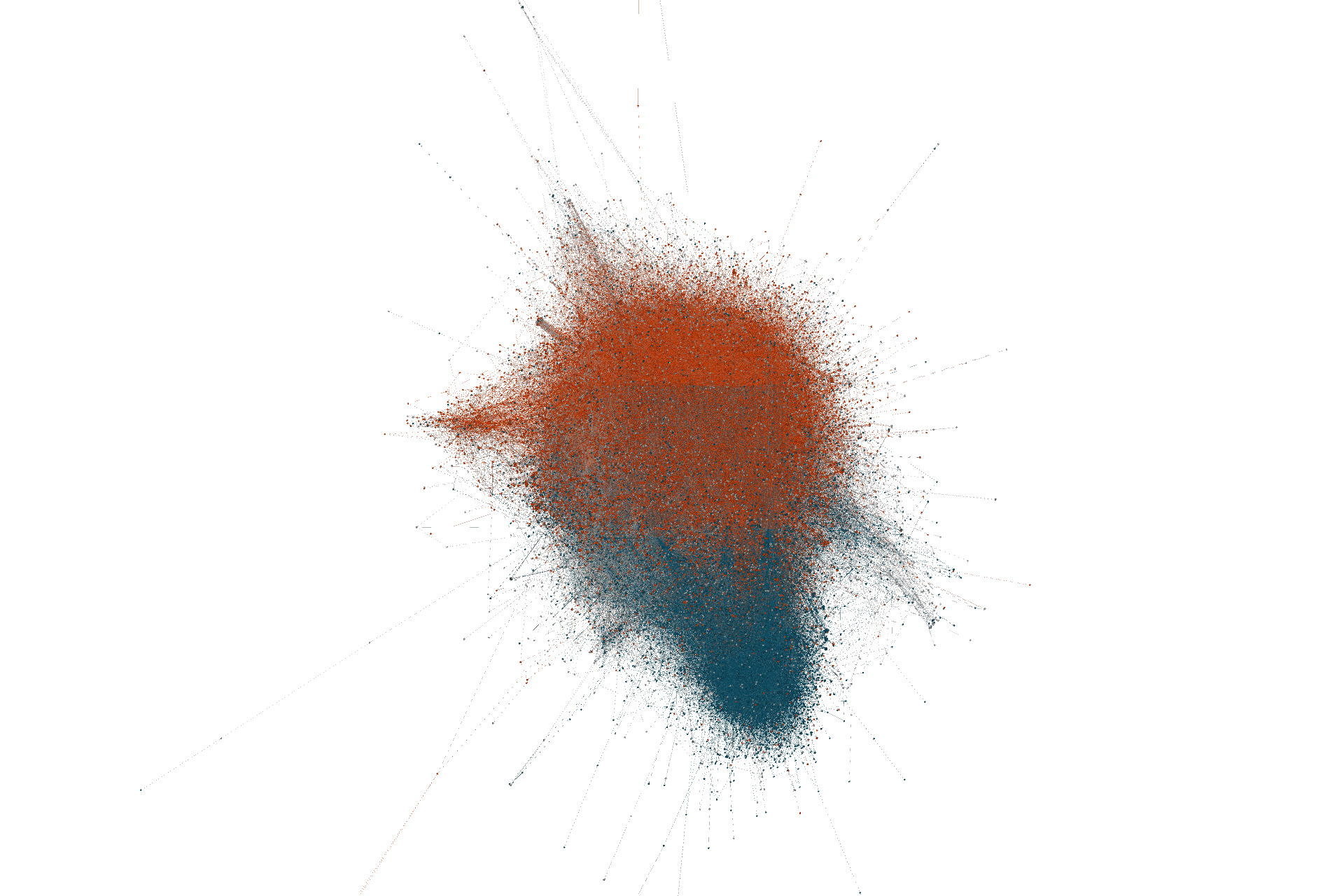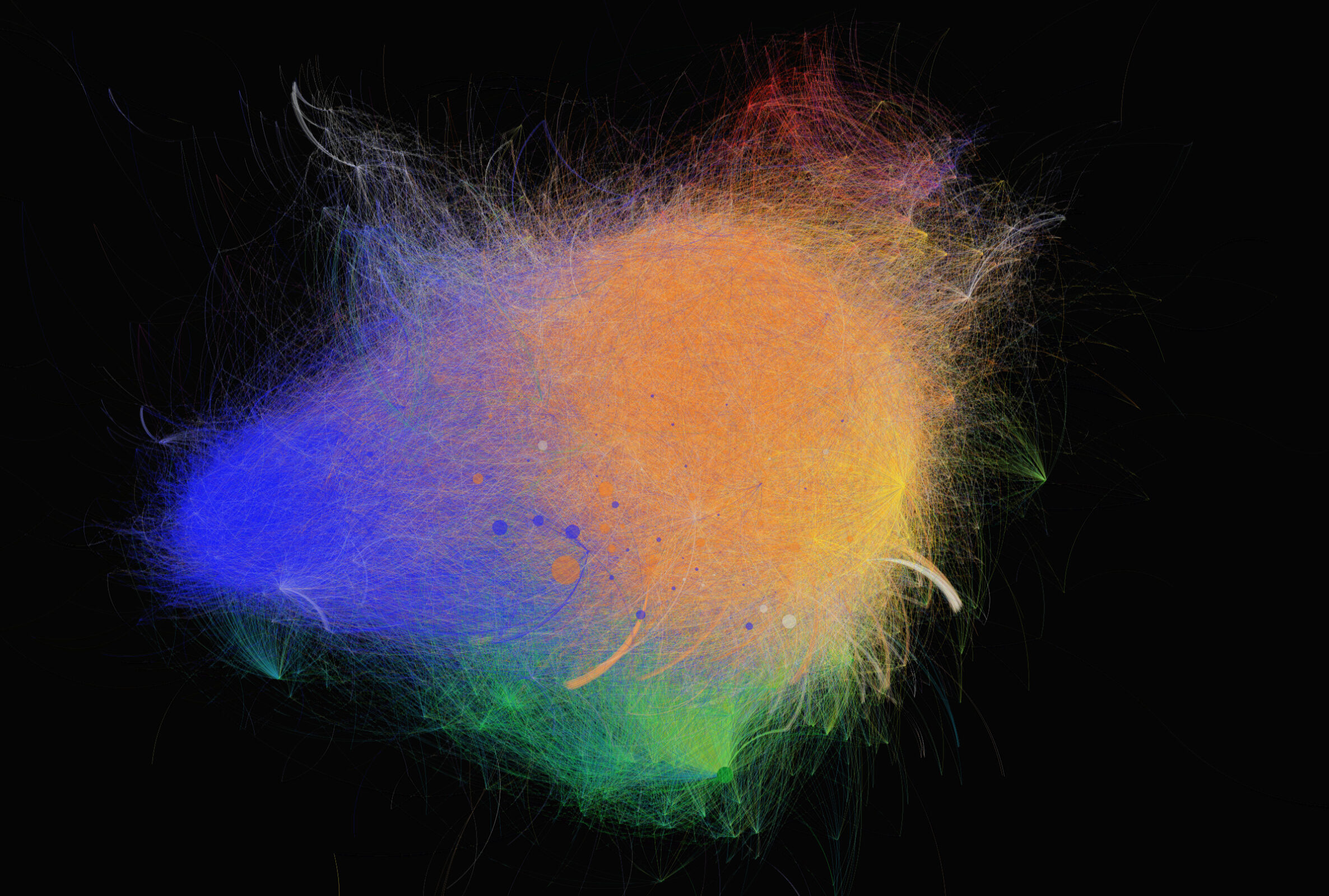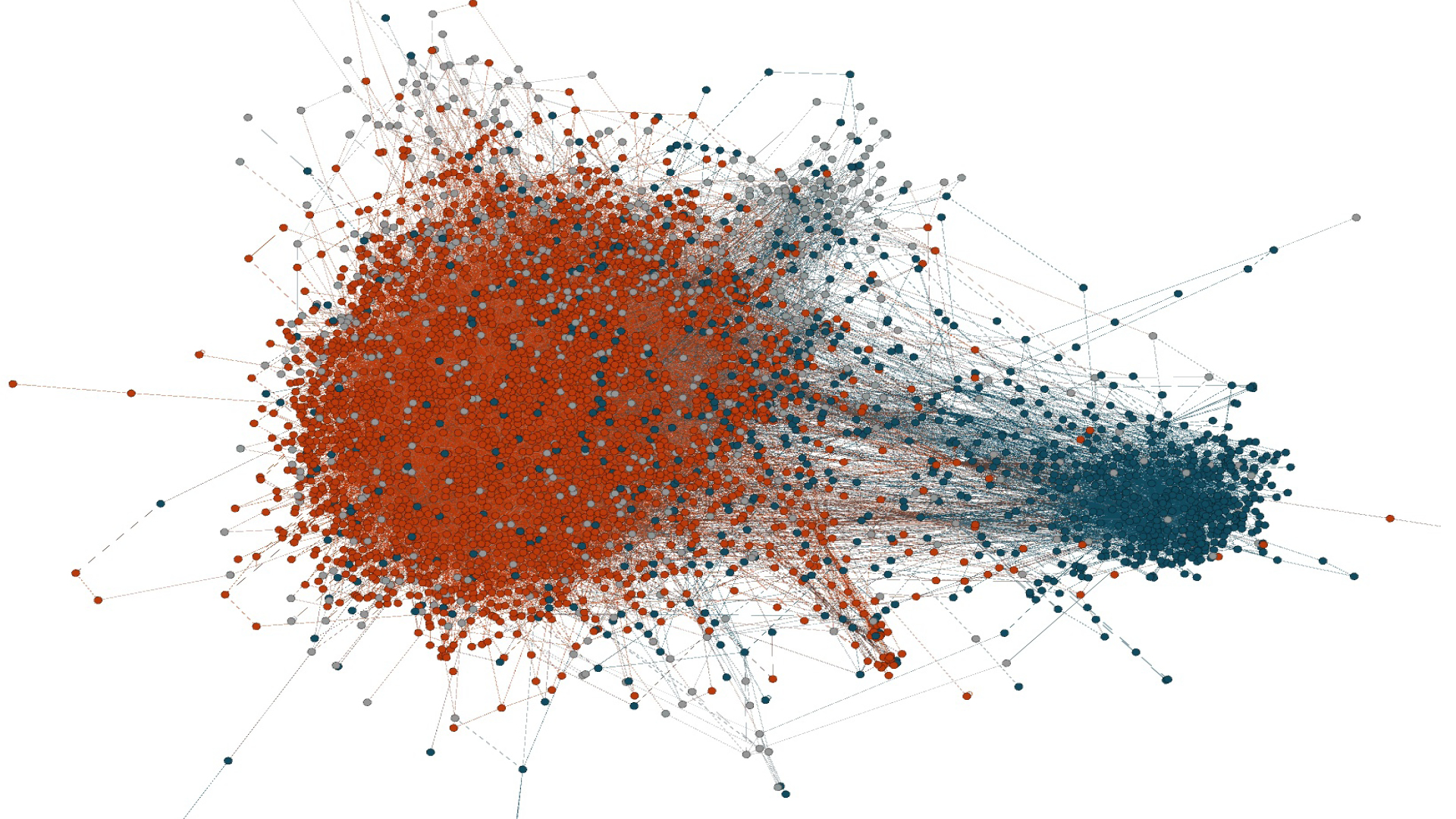The journalistic revelations about the Greek wiretapping scandal have intensified the user engagement in the digital conversation. About 70% of the relevant tweets are posted by accounts that tend to mostly follow parties and members of the political Left than the Right. In any case, this conversation continues to polarize the two groups. iMEdD Lab and Datalab present a research collaboration analyzing the course of the conversation about the wiretapping scandal on Twitter over the last nine months.
The Greek wiretapping scandal has been in the public sphere for 14 months. Journalistic and other investigative revelations began long before the case dominated the news. Indicatively, on November 14, 2021, the newspaper Efimerida ton Syntakton reports that the National Intelligence Service (NIS) is monitoring citizens, among whom a Greek journalist covering the story of a 12-year-old refugee from Syria. Two days later, the reporter and member of the journalist network Reporters United, Stavros Malihoudis, publishes an article entitled “I am the journalist under surveillance by the NIS”, explaining that he became aware of the fact by reading the aforementioned story in the Efimerida ton Syntakton. Four weeks later, on December 16, 2021, two different studies are published, by the University of Toronto’s Citizen Lab and by Meta, on the unknown and new at the time Predator spyware, with its clients possibly extending to Greece. In the first week of January 2022, the journalism group Reporters United and the paywalled Inside Story published investigations into the passing of an amendment in the Greek parliament on March 31, 2021 that altered the rules for the lifting of confidentiality of communications in our country and for Predator and “business in Greece” respectively. In the months that followed, the two groups were at the forefront of the journalistic investigation into the issue of surveillance and wiretapping, which however took a long time to start being extensively covered by the mainstream media and –consequently?– widely discussed by citizens.
The beginning of the conversation and its evolution over time
The research and data analysis, presented below in relation to the corresponding discussion on Twitter, began in November 2022 and was conducted retrospectively, with the study period starting on April 1, 2022.
On April 6, 2022, the journalist Thanasis Koukakis files a complaint with the Hellenic Authority for Communication Security and Privacy (ADAE), requesting an investigation into the case of infection of his cell phone with Predator spyware. A few days later, journalists Tasos Telloglou and Eliza Triantafyllou publish two related investigations in Inside Story, under the headlines “Who was monitoring journalist Thanasis Koukakis’s cell phone?” and “Koukakis surveillance case: The state knows” on April 11 and 14 respectively. Also, on April 15, journalists Nikolas Leontopoulos and Thodoris Chondrogiannos published an investigation in Reporters United, according to which the government was monitoring journalist Thanasis Koukakis. In the meantime there has been a statement by the Deputy Minister to the Prime Minister and Government Spokesperson, Yiannis Economou, where he had referred to the Koukakis case as surveillance by a private individual, stating among others that “obviously it is unthinkable in a country like Greece, under the rule of law, for any private individual to be able to monitor another private individual” –a statement that Thanasis Koukakis himself had commented on Twitter.
As the data shows, it is exactly then, in mid-April 2022, that user activity begins to emerge, but it only lasts a few days.
On May 19, 2022, Google’s Threat Analysis Group announced their assessment, put forth “with high confidence”, that government-backed actors in at least eight countries, including Greece, have obtained exploit software. One day later, the conversation about wiretapping on Twitter seemed to reach a comparatively important peak for that particular time period. Nonetheless, users actually began to discuss the issue only after it was made public that the MEP and president of PASOK-KINAL, Nikos Androulakis, reported the attempted wiretapping of his cell phone, an incident that is widely covered by the media.
From the end of July onwards, the wiretapping scandal conversation on Twitter is sustained and peaking every time there is a major media revelation. Most daily posts are published on August 5, 20222, the date of the resignation of the Secretary General of the Prime Minister and the head of the National Intelligence Service. Most unique accounts have been involved in the conversation in August and November 2022.
From the end of July onwards, the wiretapping scandal conversation on Twitter is sustained and peaking every time there is a major media revelation or an event of political significance that is widely covered by the media, as shown by the analysis of the total volume of 953,722 tweets from the social medium studied, between April 1, 2022 and January 14, 2023 –which included tweets, retweets, quotes and replies of users to the posts of others. Indicatively, most tweets regarding the subject of wiretapping are recorded on August 5, 2022, the date of the resignation of the Secretary General of the Prime Minister Grigoris Dimitriadis and the head of the National Intelligence Service (NIS) Panagiotis Kontoleon. It is one day after the publication of a journalistic investigation by the group Reporters United and the Efimerida ton Syntakton, according to which Grigoris Dimitriadis’s transactions are linked to Felix Bitzios, former manager of the company Intellexa which markets the Predator spyware.
Users retweet more than they tweet
Looking at the evolution of tweets over time by type of post, it turns out that, as expected, retweets are consistently several times more numerous than tweets, indicating that users join the conversation more often in order to retweet than to post their own primary comments and information.
From April 1, 2022 to January 1, 2023, approximately 37,000 unique accounts have been identified to have been involved in the conversation, with their distribution by month being in line with the progression of tweets: more unique users have been active on Twitter in August 2022 and November 2022, amounting to approximately 22,000 and 21,000 unique accounts respectively. It should be noted that, especially regarding November 2022, the peak of the conversation is recorded on November 7, when the newspaper Documento publishes the first list of public figures allegedly under surveillance –and the conversation peaks again almost simultaneously with every similar publication, but the volume of posts on Twitter is not comparable to the one that occurred on November 7.
Over the same nine-month study period, the number of unique users who have posted primary tweets amounts to 11,846. Of these, 60% also retweet content of other users, 40% reply to other people’s tweets and 26% quote commented tweets that have been originally posted by other accounts.
“Obviously on Twitter it’s very rare that an ordinary user is solely a content producer, without interacting with others and retweeting content from others; as Twitter is a public discussion forum that is popular precisely for enabling this interaction. Twitter accounts that, while publishing content, will very rarely be retweeting are usually not owned by ordinary users, but by organizations (e.g. media, political parties, etc.) that produce original content (often initially outside of Twitter) and use Twitter mainly for its circulation. In a “hierarchy” based on the ability of a Twitter account to produce meaningful and original content, the “highest” levels would consist of those who post on Twitter without retweeting, without interaction –although this is also a bit rare” says Ioannis Andreadis, Professor at the School of Political Sciences of the Aristotle University of Thessaloniki and Director of the Graduate Program in Political Analysis, commenting on the fact that the majority of users who tweet also appear to retweet. That being so, in the remaining 40% of unique accounts that reportedly do tweet but do not retweet third-party content, one should expect to find stakeholders who see Twitter more as a vehicle for distributing their own content and less as a platform for engaging in an open public dialogue.
In a “hierarchy” based on the ability of a Twitter account to produce meaningful and original content, the “highest” levels would consist of those who post on Twitter without retweeting, without interaction
Professor Ioannis Andreadis
A similar pattern emerges when analyzing from a different perspective: between April 1 and January 1, 2023, 27,781 unique accounts were found to have retweeted. Of these, only 25% have also posted their own primary content. Of course, the two sets of users partially overlap. However, interestingly, it appears that the majority of active users, in terms of posting primary content, also remain active in terms of interacting with third-party content. However, those who engage in the conversation mainly by retweeting are more than twice as many and do not seem to participate equally with their own content. In other words, users join the conversation assuming different roles: some as “regulators” of primary content and others essentially as an “audience” for the reproduction of content.
Account categories and the role of the media
Focusing on the type of users involved in the conversation, we studied a total of 2,262 selected unique accounts that have been active from April 1 to December 1, 2022. The set of these 2,262 unique accounts was compiled by selecting the top 500 in each of the following categories: those who have posted the most tweets; those who have responded the most to third-party tweets; those who have posted the most quotes; those who have been quoted more than others; and those who are most influential in the wiretapping controversy conversation –the latter being an algorithmic result based on graph network visualizations analysis and compiled by taking into account the retweets, mentions and replies recorded among users.
The analysis shows that while 18% of the total sample are informative accounts, including media and journalists, when we focus solely on the 500 unique users who posted the most tweets, the percentage of informative accounts rises to 35% and individuals participate by 61%. On the contrary, over 90% is the share of individuals, when it comes to the analysis of the 500 unique accounts that have posted the most replies and the other 500 that have posted the most quotes.
The above findings raise questions about the role of social media in the information flow: is Twitter still a medium that promotes the emergence of information “from below” and the free, decentralized circulation of a many-to-many message or is it now just a channel of communication and content distribution for the usual stakeholders, including the media? “I would respond that it’s a medium which does not appear to radically change the way people communicate –I don’t know if it’s addressed from many-to-many or if they are recycling themselves. Of course, information has now become an important tool for everyone and under its umbrella come various forms of information, scientific and non-scientific, valid and groundless, and so on. I think that it is essential, primarily, to establish a dialogue and to expose users to different views and ideas, so that the public sphere as such can be strengthened” comments Pantelis Vatikiotis, Assistant Professor at the Department of Communication, Media and Culture of Panteion University, Athens, whose teaching and research interests include alternative forms of information.
35% of those who have posted the most tweets are news accounts and 61% of individuals participate. In contrast, over 90% is the share of individuals when we focus on those who have published the most replies.
Moreover, regarding the fact that the users’ discussion often seems to be triggered by the latest media revelation or reporting of the latest news, he says: “If I interpret it from the perspective of the main focus of your research into wiretapping, one can also see it positively, in the sense that, at least in the Twitter sphere, there was a lot of user engagement about something that was not originally on the “mainstream media” agenda. Therefore, there can be created a competitive public sphere, if I may say so. This does not mean, however, that in other cases where a topic dominates the agenda of the “mainstream media”, it is not fueled by them through social media, since of course the “mainstream media” know that the user engagement there is very high. Consequently, this is how the mainstream media recycle their agenda.”
The most active and most influential users
The involvement of the media mainly for the purpose of posting their content, rather than interacting with other users as often, is also evident when one focuses comparatively on the following findings: while the top 20 accounts in terms of posted tweets include several news websites, the list of the top 20 accounts in terms of the number of responses to third-parties includes only the journalism group Reporters United, whose account comes in 17th place in the ranking.
On the other hand, journalists who are investigating the topic of wiretapping and/or have been the subject of surveillance, media, and journalist groups are included in the ranking of the 20 accounts that have been more mentioned than others. Among them, there are political accounts, demonstrating that users often tweet to political figures, including the Prime Minister, who occupies the tenth place on this list.
Similarly, the top 20 most influential accounts are determined with the use of an algorithm based on graph analysis that takes into account interactions between users, including mentions.
Looking at the top 20 websites list, in regards to their Twitter content traffic, based on the number of posts hyperlinked to the website, we find that this includes media outlets, the vast majority of which are harshly critical of the government –including those that have been at the forefront of reporting on the wiretapping case.
Seven out of ten tweets about the wiretapping case are by users mostly following the political Left
This appears to be consistent with the analysis of Twitter posts by the apparent political affiliation of the users who created them: for the wiretapping case, it is estimated that 70% of the total tweets between April 1 and December 1, 2022, were posted by accounts that tend to follow mostly left-wing parties and political figures, while only 20% of the volume of posts seems to come from users who follow mostly right-wing parties and political figures.
In the case of the wiretapping scandal, it seems that the accounts involved, which follow mostly left-wing parties and politicians, are more numerous (42%) and they “talk” a lot more (70% of the posts).
In fact, the findings are similar when, for comparison purposes, we analyze the conversation on the lifting of Maria Spyraki’s immunity (study period: December 15-18, 2022) and on the involvement of Eva Kaili in the so-called Qatargate scandal (study period: December 7-18, 2022). It is a different story, however, when analyzing the conversation on the injury and death of the Roma teen Kostas Fragoulis by a police officer (study period: December 4-18, 2022). In this case, which does not directly involve political figures or parties, it is estimated that 40% of the tweets come from users who follow mostly left-wing accounts and that another 40% of the tweets come from users who follow mostly right-wing accounts.
The findings are analogous when analyzing the distribution of the inferred political affiliations for the unique accounts involved in each conversation. In fact, especially in the case of the wiretapping scandal, it seems that the accounts involved, which follow mostly left-wing parties and politicians, are more numerous (42%) and they “talk” a lot more (70% of the tweets).
If the government wants to downplay an issue and let it be forgotten, it is only reasonable that there will be no tweets and retweets about it, both from the social media promotion team (initially) and from its supporters.
Professor Ioannis Andreadis
In this regard, Professor Ioannis Andreadis comments that the high participation/volume of content from accounts that are mostly following the political Left is to be expected, when it comes to a topic that mainly targets a right-wing government. “If the government wants to downplay an issue and let it be forgotten, it is only reasonable that there will be no tweets and retweets about it, both from the social media promotion team (initially) and from its supporters” he adds, while noting that it is now common and known, for all major political topics internationally, that recruited accounts participate and intensify the conversation.
“User mobilization can occur, regarding a topic; for example the case of wiretapping, which was not initially covered by the mainstream media. That may be where the difference with other cases lies: in the case of the Roma teen, which also arouses more conservative instincts, we see a balance between the involvement of users from both the Left and the Right. I think there is a connection in this aspect: the fact that the wiretapping case was brought into the news by the most independent media is reflected in how many people participated in these conversations and their approach, while when looking at other topics, such as the Roma teen case, which immediately dominated the agenda of the mainstream media, we see a different approach, at least in terms of quota” comments Assistant Professor Pantelis Vatikiotis.
The polarized conversation and Twitter as yet another “reverberation chamber”
At the same time, the conversation about the wiretapping case on Twitter appears to be polarized, in terms of like-mindedness: visualizations of account networks show that users form groups, presumably of similar views, and interact with each other. For example, the image below shows the user network on August 5, 2022, the day of the resignation of the Secretary General of the Prime Minister and the head of NIS. In the graph network visualization, users who follow mostly left-wing accounts (red) and those who follow mostly right-wing accounts (blue) are shown to be discussing in two distinct and non-overlapping groups.

“The element of like-mindedness and the way in which users affirm their ideas, their opinions and get into what we call “reverberation chambers” is actually nothing new. It does not necessarily have to do with digital media and social media, in this case. Clearly, there are some features of social media that may be more conducive to this kind of polarization, with the tools provided, the hashtags that everyone can follow, etc. Similarly, this may be reflected in the fact that users are not exposed to different perspectives, interests and beliefs, which is the case regardless of someone’s stance on the political spectrum” notes Assistant Professor Pantelis Vatikiotis.

In order to categorize the users by the political affiliation within which they allegedly “follow” more often, we used the procedure outlined below: each account that was identified as content creator in the studied sample of tweets, regarding each case in question, was positioned on the traditional left-right political spectrum, taking into account the political affiliation of the accounts it follows, including political parties, members of the Greek Parliament and Greek MEPs. Specifically, users who follow mostly SYRIZA, the Communist Party of Greece (KKE), MeRA 25 and their party members were positioned on the Left. Accounts that mostly follow New Democracy, Greek Solution and their party members were positioned on the Right. Users who mostly follow PASOK-KINAL and its party members, as well as users who follow an equal number of Left and Right political accounts, were positioned in the Center. Users who do not follow the aforementioned political accounts were defined as neutral.
The element of like-mindedness and the way in which users affirm their ideas, their opinions and get into what we call “reverberation chambers” is actually nothing new. Clearly, there are some features of social media that may be more conducive to this kind of polarization
Assistant Professor Pantelis Vatikiotis
The image below depicts the network of participants in the conversation on the wiretapping case and the interactions between them from April 1, 2022 to December 1, 2022. The graph network visualization illustrates, to a large extent, the interaction of users by groups: those who follow mostly New Democracy and its party members (blue), those who follow SYRIZA (orange), MeRA 25 (yellow) and their party members and those who follow KKE (red), PASOK-KINAL (green) and their party members respectively.

In conclusion, looking back at the case’s imprint on Twitter over the last nine months and seeing the initial, occasional rallying of users around a topic that took a long time to enter the mainstream media agenda, one could say that social media continues to advocate both the emergence of information “from below” as well as its decentralized flow. However, mass information still serves as a trigger for mass digital participation by citizens. In a circular pattern, when the latter emerges in a rush, the media begin to join the digital dialogue – which is for them essentially a vehicle for the distribution of their own content. Users, for their part, mainly retweet instead of tweeting and, through their interaction, place themselves within groups of like-minded peers; here, of course, is where we need to put a semicolon, until it is made clear in what way one’s positioning affects where the algorithm repositions them, especially recently, on Elon Musk’s Twitter. After all, on January 11, 2023, Τwitter encouraged the users to “See the Tweets they want to see”.
For more analysis and ongoing coverage of the topic, visit the Datalab web application
This is the result of a research collaboration between the iMEdD Lab and the Data & Web Science Lab (Datalab) of the School of Informatics of the Aristotle University of Thessaloniki.
Research/Data Analysis & Visualization:
Ilias Dimitriadis, Stelios Karamanidis, Pavlos Sermpezis (Datalab)
Kelly Kiki (iMEdD Lab)
Director of Datalab: Professor Athena Vakali
Additional research assistance:
Dimitrios-Panteleimon Giakatos, Vasileios Psomiadis (Datalab)
Phoebe Fronista (iMEdD)
Translation: Evita Lykou
The data was collected programmatically by the Datalab group, with the use of Twitter API (Application Programming Interface) v2, for academic research purposes. The following hashtags and keywords were used to collect data about the wiretapping conversation on Twitter: υποκλοπές, υποκλοπη, #υποκλοπες, #υποκλοπές, #παραρακολουθήσεις, επισύνδεση, επισυνδέσεις, #επισυνδέσεις, #δημητριαδης, #κοντολεων, #κουκακη, #ανδρουλακης, #ypoklopes, predator, #predator, #predatorgate, #pega, #spyware, #watergate, greekwatergate. The analysis presented herein is based on and limited to posts made on Twitter after April 1, 2022 including any of the aforementioned hashtags/keywords (either combined or not). Noted that, for reasons related to ensuring the relevance of the data to the subject of the conversation on the wiretapping case under study: a) the hashtag #ανδρουλακης (androulakis) was added to the data collection criteria on July 20, 2022, b) this and other hashtags corresponding to the surnames of individuals were included in the data collection criteria until November 28, 2022. For the hashtags and keywords used as data collection criteria for the purposes of comparative research with other recent news topics, as well as for more detailed information on the methodology, please read here.


